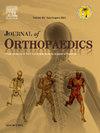Prognostic factors and treatment outcomes of malignant peripheral nerve sheath tumors (MPNST) of the extremities: A tertiary cancer institutional analysis
IF 1.5
Q3 ORTHOPEDICS
引用次数: 0
Abstract
Introduction
Malignant peripheral nerve sheath tumor (MPNST) is an uncommon and aggressive ectomesenchymal soft tissue sarcoma that usually originates from peripheral nerves or pre-existing neurofibromas. These tumors are recognised for their high metastatic risk and challenging cases to treat. The purpose of this study was to analyse the factors impacting patient prognosis and treatment options by analysing treatment results and prognostic factors in patients with MPNST of the extremities.
Materials and methods
This retrospective longitudinal study included 53 patients with histologically and immunohistochemically confirmed MPNST of the extremities, treated at a tertiary care cancer centre from 2011 to 2018. Data were collected on demographics, clinical presentation, treatment modalities (surgery, radiotherapy, chemotherapy, palliative care), and follow-up. Follow-up included physical exams, imaging, and CECT thorax at 3–6 month intervals for two years, then biannually for three more years.Variables assessed for prognostic impact included age, sex, NF1 status, tumor grade, size, location, margin status, metastasis at diagnosis, and treatment intent. Disease-free survival (DFS) was measured from the date of surgery, and overall survival (OS) from the date of diagnosis.
Results
Among 53 patients with MPNST of the extremities, 52.83 % were over 45 years of age, and 63 % were male and 37 % were females. Most tumors (86.79 %) were sporadic, with NF1-associated tumors accounting for 13.20 %. Primary disease was more common (66.03 %) than recurrent (33.96 %). High-grade tumors were predominant, with 24.52 % classified as Grade 2 and 45.28 % as Grade 3. Metastatic disease was present in 20.75 % of cases. Tumor size was variable, with the largest proportion (32 %) in the 5–10 cm range. Curative treatment was administered to 67.92 % of patients, while 32.07 % received palliative care. Adjuvant radiotherapy was given to 35.64 % of patients, and chemotherapy (doxorubicin + ifosfamide) was administered to those with metastases. The overall survival rate was 58.46 %. Tumor grade (G2, G3), metastatic presentation, and intent of treatment were significantly associated with survival outcomes. NF1 status did not significantly impact overall survival, though NF1-positive patients benefited significantly from adjuvant radiation. Tumor grade was a strong predictor of survival, with Grade 3 tumors showing poorer outcomes than Grades 1 and 2.
Conclusion
Our current study focuses on the predictive importance of treatment intent, tumor grade, and metastatic manifestation in patients with malignant peripheral nerve sheath tumors (MPNST) of the extremities. While variables such as age, gender, tumor size, surgical margin status, and NF1 status exhibited varying correlations, the most accurate predictors of survival were tumor biology, namely histological grade and metastatic occurrence.The cornerstone of curative treatment continues to be postoperative radiation after wide local excision with negative surgical margins. The results highlight the necessity of aggressive care and early detection, particularly in high-grade or NF1-associated patients.
四肢恶性周围神经鞘肿瘤(MPNST)的预后因素和治疗结果:一项三级癌症机构分析
恶性周围神经鞘瘤(MPNST)是一种罕见的侵袭性外充质软组织肉瘤,通常起源于周围神经或已有的神经纤维瘤。这些肿瘤因其高转移风险和具有挑战性的治疗病例而被认可。本研究的目的是通过分析四肢MPNST患者的治疗结果和预后因素,分析影响患者预后和治疗方案的因素。材料和方法本回顾性纵向研究纳入了2011年至2018年在三级护理癌症中心接受治疗的53例组织学和免疫组织化学证实的四肢MPNST患者。收集了人口统计学、临床表现、治疗方式(手术、放疗、化疗、姑息治疗)和随访方面的数据。随访包括体格检查、影像学检查和胸部ct检查,每隔3-6个月进行一次,然后每隔3年进行一次。评估预后影响的变量包括年龄、性别、NF1状态、肿瘤分级、大小、位置、边缘状态、诊断时转移和治疗意图。从手术之日起测量无病生存期(DFS),从诊断之日起测量总生存期(OS)。结果53例肢体MPNST患者中,年龄≥45岁的占52.83%,其中男性占63%,女性占37%。大多数肿瘤为散发型(86.79%),其中nf1相关肿瘤占13.20%。原发病(66.03%)多于复发病(33.96%)。高级别肿瘤占多数,2级占24.52%,3级占45.28%。20.75%的病例存在转移性疾病。肿瘤大小不一,在5-10 cm范围内占最大比例(32%)。67.92%的患者接受根治治疗,32.07%的患者接受姑息治疗。35.64%的患者接受辅助放疗,转移患者接受化疗(阿霉素+异环磷酰胺)。总生存率为58.46%。肿瘤分级(G2、G3)、转移表现和治疗意图与生存结果显著相关。尽管NF1阳性患者从辅助放疗中获益显著,但NF1状态对总生存期没有显著影响。肿瘤分级是生存的有力预测指标,3级肿瘤的预后比1级和2级肿瘤差。我们目前的研究重点是研究治疗意图、肿瘤分级和转移表现在四肢恶性周围神经鞘肿瘤(MPNST)患者中的预测重要性。虽然年龄、性别、肿瘤大小、手术切缘状态和NF1状态等变量表现出不同的相关性,但最准确的生存预测指标是肿瘤生物学,即组织学分级和转移发生。根治性治疗的基石仍然是广泛局部切除阴性切缘后的术后放疗。结果强调了积极治疗和早期发现的必要性,特别是在高级别或nf1相关患者中。
本文章由计算机程序翻译,如有差异,请以英文原文为准。
求助全文
约1分钟内获得全文
求助全文
来源期刊

Journal of orthopaedics
ORTHOPEDICS-
CiteScore
3.50
自引率
6.70%
发文量
202
审稿时长
56 days
期刊介绍:
Journal of Orthopaedics aims to be a leading journal in orthopaedics and contribute towards the improvement of quality of orthopedic health care. The journal publishes original research work and review articles related to different aspects of orthopaedics including Arthroplasty, Arthroscopy, Sports Medicine, Trauma, Spine and Spinal deformities, Pediatric orthopaedics, limb reconstruction procedures, hand surgery, and orthopaedic oncology. It also publishes articles on continuing education, health-related information, case reports and letters to the editor. It is requested to note that the journal has an international readership and all submissions should be aimed at specifying something about the setting in which the work was conducted. Authors must also provide any specific reasons for the research and also provide an elaborate description of the results.
 求助内容:
求助内容: 应助结果提醒方式:
应助结果提醒方式:


